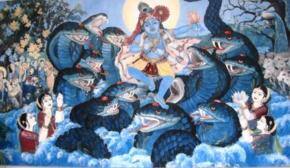Degei or Kaliya – a closer look at one of Fiji’s enduring myths

Fiji has no snakes but the Fijians believe there is a big snake, Degei, living up in a cave in the Nakavadra mountain range, in the north west of the big island, Viti Levu. Degei is believed to be the ancestral god who brought the Fijians to Fiji leading them through the ocean and landing in Vuda near Lautoka. Viseisei village in Vuda is believed to be their first settlement. From Vuda Degei travelled north reaching the Nakavadra mountain range and decided to make it his permanent home.
Interestingly, Indians have a similar story. According to Hindu mythology, Kaliya, a poisonous snake lived in the river in Vrindavan where Sri Krishnan spent his childhood among the cowherds. The water of the river became poisoned and when the cattle drank it they died. People lived in fear of Kaliya. So Sri Krishnan decided to solve the problem.
One day he climbed a big tree on the bank of the river, jumped in and started swimming. When Kaliya heard the noise he came up to check and saw what was happening. He told Sri Krishnan to get out at once. But Sri Krishnan ignored the warning and continued to swim. Incensed, Kaliya came up to Sri Krishnan and started to bite him but his bites had no effect on the little boy. Soon Sri Krishnan jumped on to the hood of Kaliya and started to dance. The rhythmic pounding with the feet caused Kaliya to vomit out all his poison. Still Sri Krishnan did not stop. As he continued Kaliya became thoroughly exhausted. Then Kaliya’s wives came and pleaded with Sri Krishnan to spare their husband’s life to which Sri Krishnan agreed on one condition.
The condition was that Kaliya should leave the river at once and go to a beautiful island, in the middle of the ocean, called Ramanaka Dweep (dweep means island). When Indians first came to Fiji they believed that was the Ramanaka Dweep where Sri Krishnan had sent Kaliya. In commemmoration of this belief the International Society for Krishna Consciousness (ISKCON) better known as the Hare Krishna Movement, when they built their first temple in Fiji, they made it the Krishna Kaliya Temple in Lautoka where the deity is Sri Krishnan dancing on Kaliya. Hindus believe that the snake that the Fijians call Degei is actually Kaliya.
Apart from the belief in Degei (Kaliya) there were other similarities between Hinduism and the old Fijian religion. The Wesleyan Missionaries had been in Fiji for about two decades before the majority of the indigenous people got converted. During this period they observed and recorded some of the old religious practices of the Fijians. We learn about these practices from the writings of the early missionaries, especially from the journals of Thomas Jagger and Thomas Williams which were later published. The latter was edited and published as ‘Fiji and the Fijians’ and gives a detailed account of the various aspects of life of the people of the islands in the 19th century.
Fijians recognised “the existence of an invisible superhuman power controlling or influencing all earthly things” but the missionaries found the religious practices of the indigenous people to be mostly based on ‘superstitions’ and spirit worship. Thomas Jagger found some of these practices akin to Jewish customs. For example, he records the practice of “shaving the head as a badge of mourning for departed deceased friends”. Shaving the head as a mark of mourning is also a Hindu custom so one could say that they also had similarities to Hindu customs.
There were other similarities to Hinduism. Williams, who has a whole chapter on ‘Religion’, noted that according to one tradition, Ndengei, ( also spelt ‘Degei’), the snake god, was represented as “directly engaged in man’s creation … like Brahma” [the creator in Hindu mythology]. Williams further noted that the belief “in a future state is universal in Fiji but their superstitious notions often border upon transmigration”. Belief in transmigration of souls is central to Hinduism.
Some of the Fijian religious practices were also akin to Hindu practices. While Williams noted that idolatory “in the strict sense of the term” was never practised by the Fijians when a miniature temple was constructed , in it a consecrated nut or stone was placed covered with turmeric powder. Hindus also put turmeric powder on stones and coconuts to consecrate them.
According to Williams each island had its own gods and each locality its own superstitions. Yet amidst all this confusion, Williams was able to trace certain main tracks of belief such as the belief in Degei as the supreme god by people all over the island group. Among the other gods, one has 8 arms, and another 8 eyes, while yet another had 2 bodies – one male and one female. All these details have similarity with Hinduism. Hindu gods often have several arms and several heads and one is half man, half woman (known as ‘Ardhanareeswaran’ which literally means the god who is half woman).
Firewalking is another common feature the two ethnic groups have. Indians, especially the South Indians, have firewalking as part of their religious tradition but they walk on hot embers rather than on hot stones as the Fijian firewalkers do. Among the Fijians the ability to walk on hot stones is confined to the people of one island, Beqa, and it is not universal. The Indian firewalking is performed only in certain temples and any devotee can choose to take part in it but certain rituals have to be observed strictly for several days before the actual event. The Fijian firewalking also seems to have been part of their old religious tradition as a traditional priest presides over the whole ceremony.
Asesela Ravuvu, a Fijian scholar, had noted: “Though Christians for more than a hundred years, important elements of the traditional system of supernatural belief survive and still influence the lives of most Fijians today”. He had further noted that the Fijians see the Christian God in very much the same way as their ancestral Gods.
Perhaps this was the reason that the Fijians did not look down upon Hindu religious practices as they could relate themselves to many of the Indian beliefs and customs. So there were hardly any religious conflicts between Fijians and Indians until 1987.




